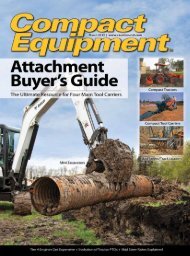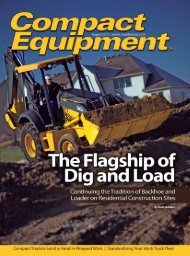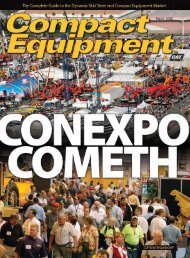CE EQUIPMENT CONNECTION - Compact Equipment
CE EQUIPMENT CONNECTION - Compact Equipment
CE EQUIPMENT CONNECTION - Compact Equipment
Create successful ePaper yourself
Turn your PDF publications into a flip-book with our unique Google optimized e-Paper software.
Breaking Out<br />
When the time comes for destruction, a CUL can be<br />
paired with a concrete breaker to rip, destroy and shatter<br />
the tough material that stands in its way. Concrete breakers<br />
are attachments that are primarily used for demolition<br />
purposes. For example, CUL breakers are often utilized to<br />
break up concrete in driveways, patios and parking lots.<br />
These heavy-duty attachments allow for areas to be broken<br />
apart and carried away for new construction to take place;<br />
attach a grapple bucket to your CUL and haul off the debris.<br />
A concrete breaker is categorized by its impact energy in ftlbs.<br />
The impact energy class can range from 150 to 300 ft-lbs<br />
for compact utility loaders.<br />
“The higher the class of the breaker, the more fl ow and<br />
pressure will be required from the hydraulic system,” explains<br />
Dan Roberts, Toro Sitework technical service representative.<br />
“Concrete breakers are also measured in blows per minute.”<br />
Like all CUL implements, the breaker is attached to<br />
the front end of a CUL through a universal quick-attach<br />
system. For a CUL to operate a breaker, it must produce 8<br />
to 12 gallons per minute (gpm) of hydraulic fl ow for the<br />
attachment to work effi ciently. When using the breaker for<br />
work on sidewalks, driveways, etc., Jaime Wines, product<br />
manager of compact utility equipment for Ditch Witch,<br />
suggests positioning it vertically and lowering it until it<br />
reaches its point of contact. Then the hydraulics should<br />
be activated and the breaker is ready to operate. Although<br />
the breaker attachment is relatively simple to operate,<br />
positioning it when operating may pose some challenges<br />
to the operator.<br />
“The big place you will have diffi culties with breaking<br />
is when you’re working pure horizontally,” says Reed.<br />
“Horizontal operation is not recommended with a compact<br />
utility loader breaker. An operator can work in any other<br />
position than horizontal. It’s mounted so it can be adjusted<br />
any way. When the breaker is working in pure horizontal<br />
applications, you’re just not maximizing its power.”<br />
A breaker attachment for a compact utility loader can<br />
range from $6,000 to $11,000, depending on manufacturer<br />
and any added options.<br />
Different chisel points, moil points and asphalt cutters<br />
are available options to customize a breaker attachment to<br />
accommodate different work conditions. By adding various<br />
dedicated chisel or moil points, an operator can handle<br />
specifi c jobsites with the best possible break point for the<br />
project. Operators should always look to adding options to<br />
customize his or her unit for particular projects.<br />
“It is important to choose the right tool and options for the<br />
material being broken,” says Roberts. “Some manufacturers<br />
offer a tamper tool option in order to compact the soil after<br />
demolition, prior to pouring new material.”<br />
A breaker attachment does require regular maintenance<br />
checks to ensure it is working properly. Today’s breaker<br />
attachments require less maintenance than those prior,<br />
especially with keeping its battery charged.<br />
“If you went back a couple of years, the breaker would need<br />
to be recharged on a frequent basis,” explains Reed. “Now they<br />
can go a year or two before needing to be recharged.” The moils<br />
on the breaker should also be checked to identify any excessive<br />
wear. The material that an operator is hammering is a big factor<br />
in how often the moils will need to be replaced. Another<br />
maintenance concern comes from the CUL itself. Since the attachment<br />
causes a vibration to the machine, parts on the CUL<br />
should be checked to ensure they are fastened on correctly.<br />
“A real challenge lies in that the hammer is vibrating all<br />
the time, so the bushings on the arms of the CUL may need<br />
to be replaced or reinforced,” says Reed. “Regular machines<br />
will need to replace the bushings once or twice a year, while<br />
a dedicated machine will have to reinforce and/or replace<br />
them every six months or a year.”<br />
Not much can stand in the way of a concrete breaker. When utilized correctly, a breaker attachment can smash large pieces of concrete.<br />
Using the breaker in a horizontal position is not recommended; the operator should reposition the attachment to truly maximize its power.<br />
compactequip.com January 2008 <strong>Compact</strong> <strong>Equipment</strong> 25








